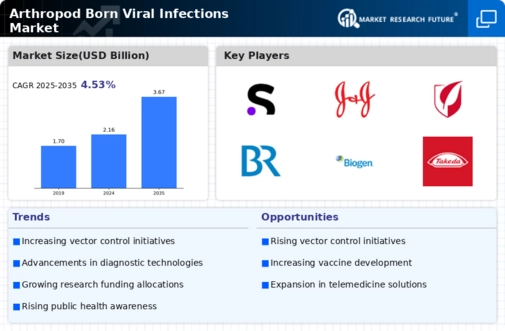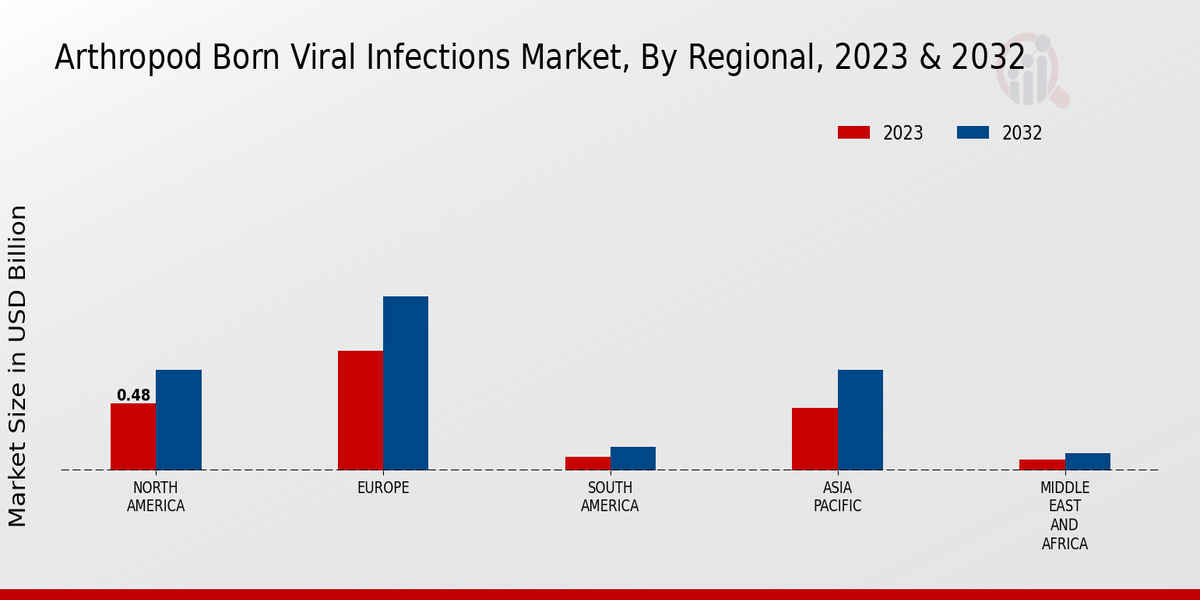Market Growth Projections
The Global Arthropod Born Viral Infections Market Industry is projected to experience robust growth over the next decade. With an estimated market value of 2.16 USD Billion in 2024, the industry is expected to reach 3.67 USD Billion by 2035, reflecting a compound annual growth rate (CAGR) of 4.93% from 2025 to 2035. This growth trajectory is indicative of the increasing investments in research and development, alongside the rising incidence of arthropod-borne diseases. As stakeholders recognize the importance of addressing these infections, the market is likely to witness the introduction of innovative solutions, further driving its expansion.
Growing Awareness and Education
The rising awareness and education regarding arthropod-borne viral infections are pivotal in influencing the Global Arthropod Born Viral Infections Market Industry. Public health campaigns and educational programs aimed at informing communities about prevention measures and symptoms are increasingly prevalent. This heightened awareness encourages individuals to seek medical attention promptly, thereby driving demand for diagnostic and therapeutic solutions. For example, initiatives that educate populations about mosquito control and personal protective measures have shown effectiveness in reducing transmission rates. As awareness continues to grow, the market is likely to experience sustained growth, aligning with the projected CAGR of 4.93% from 2025 to 2035.
Emerging Markets and Globalization
Emerging markets are becoming increasingly relevant in the Global Arthropod Born Viral Infections Market Industry. As globalization facilitates the movement of people and goods, the risk of arthropod-borne viral infections spreading to new regions escalates. Countries in Asia and Africa are particularly vulnerable due to their climatic conditions and public health infrastructure. The expansion of international travel and trade has led to the introduction of diseases in previously unaffected areas, necessitating the development of targeted interventions. This dynamic environment presents opportunities for market players to innovate and adapt their strategies to meet the evolving challenges posed by these infections.
Government Initiatives and Funding
Government initiatives aimed at combating arthropod-borne viral infections play a significant role in shaping the Global Arthropod Born Viral Infections Market Industry. Increased funding for research and development, as well as public health campaigns, are critical in addressing the challenges posed by these diseases. For instance, various countries have implemented vector control programs and vaccination drives to mitigate the impact of outbreaks. Such initiatives not only enhance public awareness but also stimulate market growth by fostering innovation in treatment options. The commitment of governments to allocate resources towards these efforts is expected to sustain the market's expansion in the coming years.
Advancements in Diagnostic Technologies
Technological innovations in diagnostic methods are transforming the Global Arthropod Born Viral Infections Market Industry. Enhanced diagnostic tools, such as rapid molecular tests and point-of-care testing, allow for quicker and more accurate identification of viral infections. This is crucial for timely intervention and management of outbreaks. For example, the development of next-generation sequencing has improved the detection of arboviruses, facilitating better epidemiological tracking. As these technologies become more accessible, they are likely to drive market growth, contributing to an anticipated market size of 3.67 USD Billion by 2035. The integration of advanced diagnostics into public health strategies is essential for effective disease control.
Rising Incidence of Vector-Borne Diseases
The increasing prevalence of vector-borne diseases globally is a primary driver of the Global Arthropod Born Viral Infections Market Industry. Factors such as climate change, urbanization, and globalization contribute to the expansion of habitats suitable for arthropod vectors. For instance, diseases like dengue and Zika virus are becoming more widespread, leading to heightened public health concerns. This trend is reflected in the projected market value of 2.16 USD Billion in 2024, indicating a growing need for effective prevention and treatment strategies. As the incidence of these diseases rises, the demand for vaccines and antiviral therapies is expected to increase significantly.
























Leave a Comment